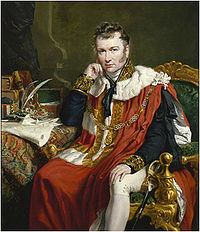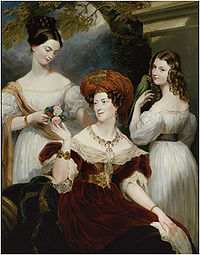- Charles Stuart, 1st Baron Stuart de Rothesay
-
 Lord Stuart de Rothesay painted in Paris by George Hayter, 1830.
Lord Stuart de Rothesay painted in Paris by George Hayter, 1830.
Charles Stuart, 1st Baron Stuart de Rothesay GCB, PC (2 January 1779–6 November 1845), known as Sir Charles Stuart between 1812 and 1828, was a British diplomat. He was twice Ambassador to France and also served as Ambassador to Russia between 1841 and 1844.
Contents
Background and education
Stuart was the son of Lieutenant-General the Honourable Sir Charles Crichton-Stuart, younger son of Prime Minister John Stuart, 3rd Earl of Bute. His mother was Louisa, daughter of Lord Vere Bertie, younger son of Robert Bertie, 1st Duke of Ancaster and Kesteven. He was educated at Eton and Christ Church, Oxford.[1]
Diplomatic career
Stuart joined the Diplomatic Service in 1801 and served as Envoy Extraordinary and Minister Plenipotentiary to Portugal and Brazil between 1810 and 1814. He was appointed a Knight of the Order of the Bath (KB) in 1812[2] and sworn of the Privy Council in 1814.[3] In 1815 he was made a Knight Grand Cross of the Order of the Bath (GCB)[4] and appointed British Ambassador to France. He remained in Paris until 1824 and was also briefly Ambassador to Holland between February and May 1815. From 1825 to 1826 he was once more Envoy Extraordinary and Minister Plenipotentiary to Portugal and Brazil. He was created Count of Machico in 1825 by John VI of Portugal and Marquess of Angra in Brazil in 1826 by Maria II of Portugal, and was a Knight of the Portuguese Order of the Tower and Sword.[1] In 1825 the Portuguese King John VI named Stuart his plenipotentiary with powers to negotiate and sign with Brazil a Treaty on the recognition of that country's independence. Invested with those powers, Stuart signed the treaty recognizing Brazilian independence on 29 August 1825, and on 15 November of the same year the Portuguese King ratified the treaty. In January 1828 he was once again appointed Ambassador to France and was raised to the peerage Baron Stuart de Rothesay, of the Isle of Bute, at the same time.[5] He continued as Ambassador to France until 1831. In 1841 he was made Ambassador to Russia, a post he held until 1844.[1]
Family
 Stuart's wife Elizabeth, Lady Stuart de Rothesay, and daughters Charlotte (later Countess Canning) and Louisa (later Marchioness of Waterford), painted in Paris by George Hayter, 1830.
Stuart's wife Elizabeth, Lady Stuart de Rothesay, and daughters Charlotte (later Countess Canning) and Louisa (later Marchioness of Waterford), painted in Paris by George Hayter, 1830.
Lord Stuart de Rothesay married Lady Elizabeth Margaret, daughter of Philip Yorke, 3rd Earl of Hardwicke, on 6 February 1816. They had two daughters:
- Hon. Charlotte Stuart (1817–1861), wife of Charles Canning, 1st Earl Canning.
- Hon. Louisa Anne Stuart (1818–1891), wife of Henry Beresford, 3rd Marquess of Waterford.
Between 1831 and 1835 Lord Stuart de Rothesay constructed Highcliffe Castle at Highcliffe, Dorset. The estate had previously been sold by his father.[6] Lord Stuart de Rothesay died in November 1845, aged 66, when the barony became extinct. Lady Stuart de Rothesay remained a widow until her death in June 1867.[1]
References
- ^ a b c d thepeerage.com Charles Stuart, 1st and last Baron Stuart de Rothesay
- ^ London Gazette: no. 16650. p. 1966. 26 September 1812.
- ^ London Gazette: no. 16938. p. 1913. 24 September 1814.
- ^ London Gazette: no. 16972. p. 18. 4 January 1815.
- ^ London Gazette: no. 18433. p. 122. 18 January 1828.
- ^ highcliffecastle.co.uk
- Oliver & Boyd's New Edinburgh Almanack for the year
Diplomatic posts Preceded by
Hon. John VilliersEnvoy Extraordinary and Minister Plenipotentiary
to Portugal and Brazil
1810 – 1814Succeeded by
Thomas SydenhamPreceded by
The Duke of WellingtonBritish Ambassador to France
1815–1824Succeeded by
The Viscount GranvillePreceded by
The Viscount GranvilleBritish Ambassador to France
1828–1830Succeeded by
The Viscount GranvillePreceded by
The Marquess of ClanricardeBritish Ambassador to Russia
1841–1844Succeeded by
Hon. John BloomfieldPeerage of the United Kingdom New creation Baron Stuart de Rothesay
1828 – 1845Extinct Categories:- 1779 births
- 1845 deaths
- Barons in the Peerage of the United Kingdom
- British diplomats
- Knights Grand Cross of the Order of the Bath
- Diplomatic peers
- Ambassadors of the United Kingdom to France
- Stuart of Bute family
- Members of the Privy Council of the United Kingdom
- Ambassadors of the United Kingdom to Portugal
- Ambassadors of the United Kingdom to Russia
- Peerage of the United Kingdom baron stubs
Wikimedia Foundation. 2010.
